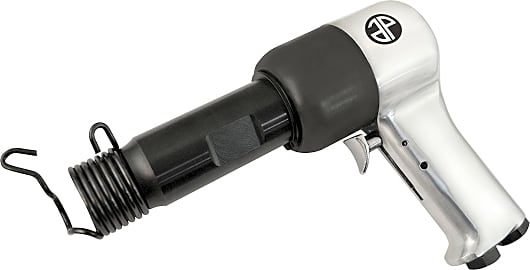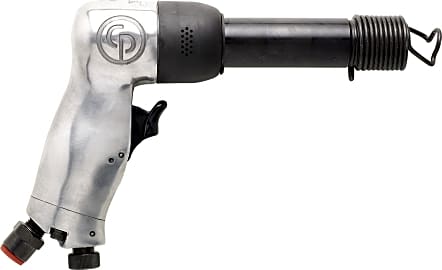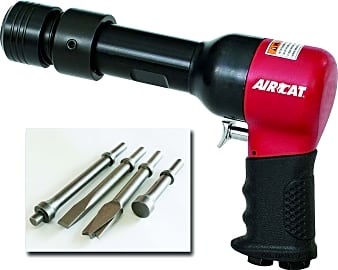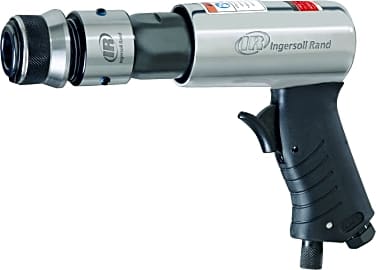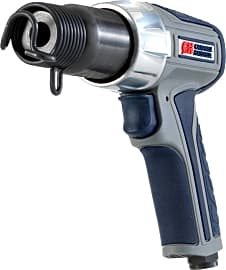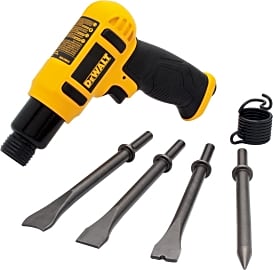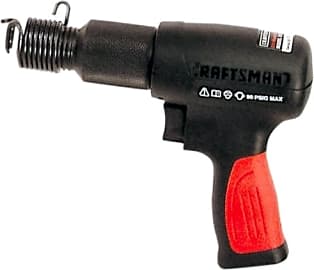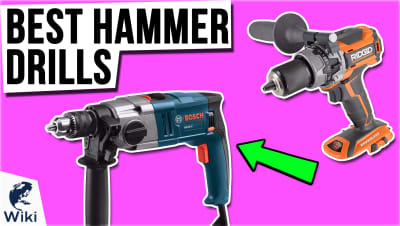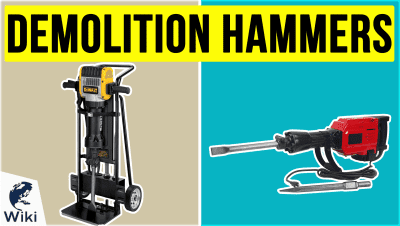The 10 Best Air Hammers

This wiki has been updated 38 times since it was first published in June of 2015. If you work in an automotive shop or any industrial setting, or remodel homes, sometimes a basic chisel isn't enough to get the job done — at least not if you don't want to be at it all day. One of these air hammers will give you all the power you need to tackle any projects. We have included both short and long-barrel models, while taking into account price and overall performance. When users buy our independently chosen editorial selections, we may earn commissions to help fund the Wiki.
Editor's Notes
February 11, 2021:
We replaced the Ingersoll Rand 122MAX with its logical successor, the Ingersoll Rand 123MAX. Although the two tools have designs that are quite similar to one another, we favored the 123MAX because it’s more compact and lightweight than the 122MAX.
We also eliminated the Kobalt SGY-AIR132, which wasn’t available at the time of this update, and filled its spot with the Craftsman 9-19897, which isn’t the most powerful model on the market, but still seemed worth including at the bottom of our list, as a wallet-friendly option for at-home mechanics who rely on the tool for infrequent, medium-duty work.
In case you’re very new to this space, note that these pneumatic tools are not electric hammer drills, and will all require a separately purchased compressor and air hose to function.
December 05, 2019:
Added the Aircat 5300-A-T. There are many positives about the Aircat - it features a long barrel which will always result in more forceful impacts when compared to the short and medium length barrel sizes. The quick-connect coupler is also a better method of retaining chisels than springs and it saves a bit of set-up time. Like with most of these hammers, the air demand is high but the efficiency is well worth it. From experience I can say that the Aircat has a very comfortable handle, but whether that holds for another individual will be a personal preference.
The Astro Pneumatic Tool 4980 is massively powerful (there's a reason people call it 'big nasty') at a fraction of the cost of truck tools. It has excellent build quality but I would suggest swapping out the spring retainer for a quick-connect. Another thing to keep in mind is that it has a wide 0.498-inch shank which will make chisels harder to find as opposed to the standard 0.401-inch shank.
Working with pneumatic tools is inherently dangerous so they should be used with care to avoid injury. Always wear eye protection.
The Power Is In The Air
What that means is that they utilize air pressure to create the force of the blow.
Air hammers are pneumatic tools, and, for the record that's a silent 'p' in pneumatic. What that means is that they utilize air pressure to create the force of the blow.
At a certain place on the tool, most often the bottom of the handle, there's a little nozzle that attaches to a hose running to an air compressor.
When air from the compressor reaches the hammer, it moves an internal piston with incredible force that translates directly to a bit, usually a chisel or similar element. Internally, the units are rather simple, which is lovely, since that usually implies durability.
That chisel bit is interchangeable with a whole slew of tools, from ends that allow you to use your air hammer more like a simple hammer, to the chisels we mentioned above, and more.
One of the most common pneumatic hammers you've probably seen in use is a kind of extra large version we usually call a jackhammer. When air powered (there are electric models), the jackhammer works by the same mechanism as the air hammer, just on a different scale.
Ends For Your Means
Air hammers are a little bit like pizzas. They're all pretty much made from the same ingredients, though the quality of those ingredients can differ. They all do the job you ask them to, which in the air hammer's case is to drive your chisel, hammer, or other element, and which, in the pizza's case, is to satisfy your hunger.
There's also the question of intended application, which has greatly to do with the power behind an air hammer's blows.
Where the comparison fails is in durability, reliability, and price variance. If you can find me a posh slice of 'za that's nearly three times more than the average price, there's a good chance I'll want to try it, but only if you're buying, and I don't think it's going to last any longer in the fridge than that cheap slice from the corner.
So, how do you choose your pizza? Well, it's going to have a lot to do with price to start, but there are also important considerations beyond that. Getting back to the air hammers, if you're looking to make an investment, odds are the least expensive option isn't the one built to last your lifetime and handle anything you throw its way.
There's also the question of intended application, which has greatly to do with the power behind an air hammer's blows. If you have heavier duty jobs in front of you, you're going to need a pricier unit. It's pretty much a directly proportional relationship.
If the toughest thing you have in your future is automotive work on your SUV or lighter, you'll be just fine without the best air hammer on the market. The attachments are almost endless (like toppings!), so as long as you don't need that extra burst of power you should be able to find the end you need to fit the job at hand.
The only downside in buying a cheaper air hammer is that you can't grow with it. But, then again, you can't grow with pizza either.
Pneumatic By Another Name
We call them air hammers, presumably because spelling and pronouncing 'pneumatic' is not, well, automatic. Now, I know you know what 'automatic' means, but it's educational if we break it down here. 'Auto-' is from the Greek for self, or one's own, and '-matic' from the Greek for thinking, or animation.
We call them air hammers, presumably because spelling and pronouncing 'pneumatic' is not, well, automatic.
In a language called Proto-Indio-European, that is supposed to have existed between 4500 and 2500 BCE and which left no written textual record, etymologists believed there was the word 'pneu-' meaning to breathe.
So pneumatic comes from the marriage of breath and animation, or "to be powered by air."
It was in the late 19th century that an inventor named Jon W. Duntley began to develop what would become the world's first pneumatic hammer. With a big investment from the steel magnate Charles Schwab, the patent hit in late December of 1901, and an industry was born.
Since then, advances in the safety and accuracy of the hammers themselves, as well as increases in the power harnessed by the air compressor itself, have placed the power of this industry capably in the hands of everyday homeowners and handy folk.


